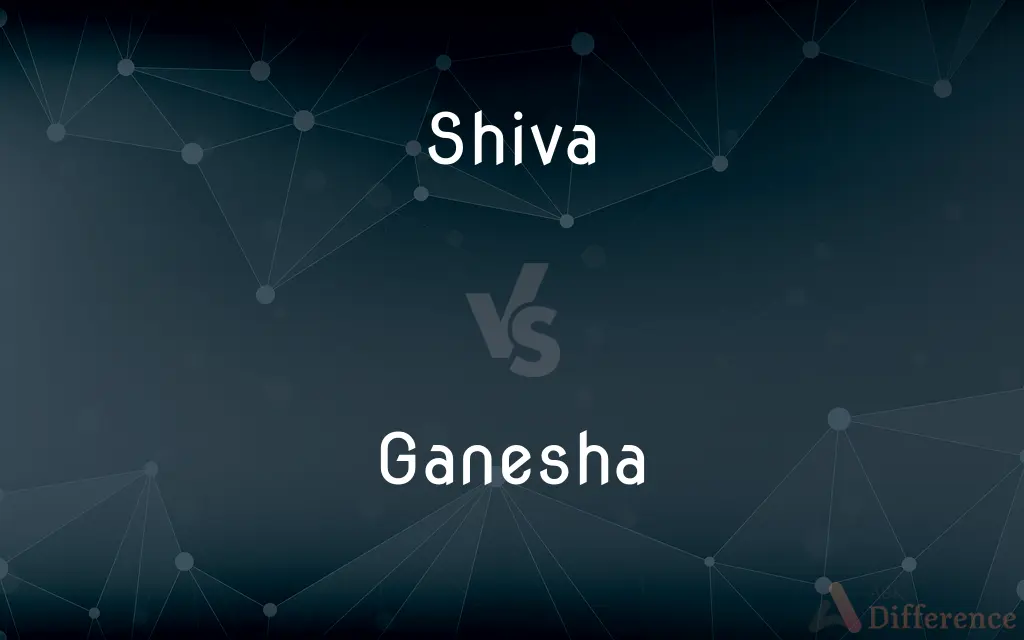Shiva vs. Ganesha — What's the Difference?
Edited by Tayyaba Rehman — By Urooj Arif — Updated on April 22, 2024
Shiva, a principal deity in Hinduism, is known for his role as a destroyer and transformer within the Trimurti, while Ganesha, his son, is revered as the remover of obstacles and the god of beginnings and wisdom.

Difference Between Shiva and Ganesha
Table of Contents
ADVERTISEMENT
Key Differences
Shiva is often depicted as an ascetic yogi, embodying destruction and renewal, crucial for maintaining the cosmic cycle. In contrast, Ganesha is typically shown as a cheerful, elephant-headed figure, symbolizing intellect and the ability to overcome physical and intellectual challenges.
Shiva's attributes include the crescent moon, the river Ganges flowing from his hair, and a blue throat from consuming poison during the cosmic ocean churning. On the other hand, Ganesha is easily recognized by his elephant head, a large belly, and his mount, a small mouse, which complements his role as a deity who removes obstacles.
Shiva is worshipped as a profound and complex deity associated with timelessness and the formless. Whereas Ganesha is particularly celebrated for his pragmatic abilities to ensure success and wisdom in new endeavors.
Devotees seek blessings from Shiva for inner peace and liberation from the cycle of life and death, while Ganesha is predominantly worshipped for his ability to remove obstacles and bring about prosperity in new ventures.
Festivals dedicated to Shiva include Maha Shivaratri, focusing on fasting, meditation, and reflection, contrasting with Ganesh Chaturthi, which involves public celebrations, music, and dance, honoring Ganesha’s birth.
ADVERTISEMENT
Comparison Chart
Role in Hinduism
Destroyer within the Trimurti
Remover of obstacles, god of beginnings
Iconography
Blue throat, crescent moon, trident
Elephant head, large belly, mouse mount
Symbolism
Cycle of creation, destruction, regeneration
Wisdom, intellectual and physical prowess
Worship and Festivals
Maha Shivaratri, focused on ascetic practices
Ganesh Chaturthi, celebrated with public festivities
Depiction in mythology
Ascetic, meditative, often in solitude
Cheerful, accessible, involved with worldly affairs
Compare with Definitions
Shiva
Ascetic God.
Shiva is often depicted meditating on a Himalayan peak, symbolizing his ascetic nature.
Ganesha
Remover of Obstacles.
Devotees often pray to Ganesha before starting any new venture to ensure obstacle-free progress.
Shiva
Nataraja.
As Nataraja, Shiva performs the cosmic dance to destroy a weary universe and make preparations for Brahma to create it anew.
Ganesha
Lord of Beginnings.
Ganesha is honored at the start of rituals and ceremonies as he is the lord of beginnings.
Shiva
Shiva Lingam.
The Shiva Lingam represents divine creation and destruction, embodying Shiva's all-encompassing nature.
Ganesha
Elephant-headed God.
Ganesha’s elephant head symbolizes wisdom and knowledge.
Shiva
Mahadev (Great God).
Shiva is also known as Mahadev, reflecting his supreme status among Hindu deities.
Ganesha
Vighnaharta.
Known as Vighnaharta, or the remover of obstacles, Ganesha is invoked at the beginning of prayers.
Shiva
Destroyer and Transformer.
In Hindu traditions, Shiva is revered as the cosmic destroyer, necessary for ongoing creation.
Ganesha
Patron of Arts and Sciences.
Ganesha is considered a patron of the arts and sciences, blessing intellectual pursuits.
Shiva
Shiva (; Sanskrit: शिव, lit. 'The Auspicious One' [ɕɪʋɐ] (listen), IAST: Śiva), also known as Mahadeva (; Sanskrit: महादेव:, lit. 'The Great God'), is one of the principal deities of Hinduism. He is the Supreme Being in Shaivism, one of the major traditions within Hinduism.Shiva has pre-Vedic tribal roots, and the figure of Shiva as we know him today is an amalgamation of various older non-Vedic and Vedic deities, including the Rigvedic storm god Rudra who may also have non-Vedic origins, into a single major deity.Shiva is known as "The Destroyer" within the Trimurti, the triple deity of supreme divinity that includes Brahma and Vishnu.
Ganesha
Ganesha (Sanskrit: गणेश, IAST: Gaṇeśa), also known as Ganapati and Vinayaka, is one of the best-known and most worshipped deities in the Hindu pantheon. His image is found throughout India, Nepal, Sri Lanka, Thailand, Indonesia (Java and Bali), Singapore, Malaysia, Philippines, and Bangladesh and in countries with large ethnic Indian populations including Fiji, Guyana, Mauritius, and Trinidad and Tobago.
Shiva
One of the principal Hindu deities, worshiped as the destroyer and restorer of worlds and in numerous other forms. Shiva is often conceived as a member of the Trimurti, along with Brahma and Vishnu.
Ganesha
The god of wisdom and the remover of obstacles, son of Shiva and Parvati, depicted as a short fat man with an elephant's head.
Shiva
A seven-day period of formal mourning observed after the funeral of a close relative.
Ganesha
Hindu god of wisdom or prophecy; remover of obstacles
Shiva
(Judaism) A weeklong period of formal mourning for a close relative.
Shiva
(Judaism) a period of seven days of mourning after the death of close relative;
The family is sitting shiva
Shiva
The Destroyer; one of the three major divinities in the later Hindu pantheon
Common Curiosities
What is the significance of Shiva's blue throat?
Shiva's blue throat, resulting from consuming poison during the cosmic ocean's churning, symbolizes his sacrifice and control over destructive forces.
Why is Ganesha depicted with an elephant head?
Ganesha’s elephant head symbolizes wisdom, understanding, and a discriminating intellect necessary to overcome obstacles.
What role does Ganesha play in Hindu festivals?
Ganesha plays a central role in Ganesh Chaturthi, a festival that celebrates his birth and his ability to remove obstacles.
What does Shiva's dance signify?
Shiva's cosmic dance, Nataraja, signifies the cycles of creation, preservation, and dissolution.
Why do people pray to Ganesha before starting new projects?
People pray to Ganesha for his ability to remove obstacles and ensure smooth beginnings and successful completions.
Who are Shiva and Ganesha in Hindu mythology?
Shiva is a major Hindu deity, known as the destroyer within the Trimurti, while Ganesha is his son, known as the remover of obstacles.
How are Shiva and Ganesha worshipped?
Shiva is worshipped through rituals like Maha Shivaratri, focusing on meditation and austerity; Ganesha is celebrated in Ganesh Chaturthi with public festivities.
What does the Shiva Lingam represent?
The Shiva Lingam symbolizes Shiva’s role as the creator, protector, and destroyer of the universe.
What are the different forms of Shiva and their meanings?
Shiva’s forms include Nataraja, symbolizing cosmic cycles; Lingam, representing divine generative energy; and Rudra, a fierce aspect.
What is the cultural importance of Shiva in Hinduism?
Shiva is considered a symbol of the essential goodness, as a protector but also as the destroyer of the universe in a positive sense.
Can you explain the symbolism of Shiva’s trident?
Shiva’s trident represents his mastery over the physical, mental, and spiritual worlds.
What is the educational symbolism behind Ganesha’s head?
The large head of Ganesha symbolizes thinking big and the small mouth signifies talk less.
How do the festivals of Shiva and Ganesha differ in their celebration?
Shiva’s festival, Maha Shivaratri, involves solemn reflection and meditation, whereas Ganesh Chaturthi involves lively public celebrations.
How is Ganesha's relationship with his vehicle, the mouse, significant?
Ganesha’s vehicle, a mouse, symbolizes the ability to penetrate even the most intricate places to remove obstacles.
What is the mythological story behind Ganesha’s elephant head?
Mythologically, Ganesha received his elephant head after Shiva decapitated him and then replaced his head with that of an elephant as a solution to bring him back to life.
Share Your Discovery

Previous Comparison
Childhood vs. Youth
Next Comparison
Featherweight vs. BantamweightAuthor Spotlight
Written by
Urooj ArifUrooj is a skilled content writer at Ask Difference, known for her exceptional ability to simplify complex topics into engaging and informative content. With a passion for research and a flair for clear, concise writing, she consistently delivers articles that resonate with our diverse audience.
Edited by
Tayyaba RehmanTayyaba Rehman is a distinguished writer, currently serving as a primary contributor to askdifference.com. As a researcher in semantics and etymology, Tayyaba's passion for the complexity of languages and their distinctions has found a perfect home on the platform. Tayyaba delves into the intricacies of language, distinguishing between commonly confused words and phrases, thereby providing clarity for readers worldwide.
















































